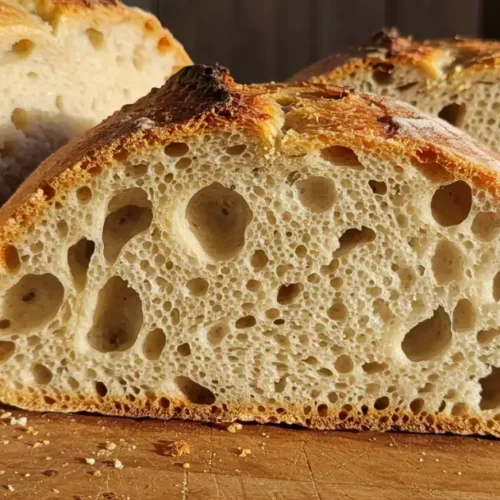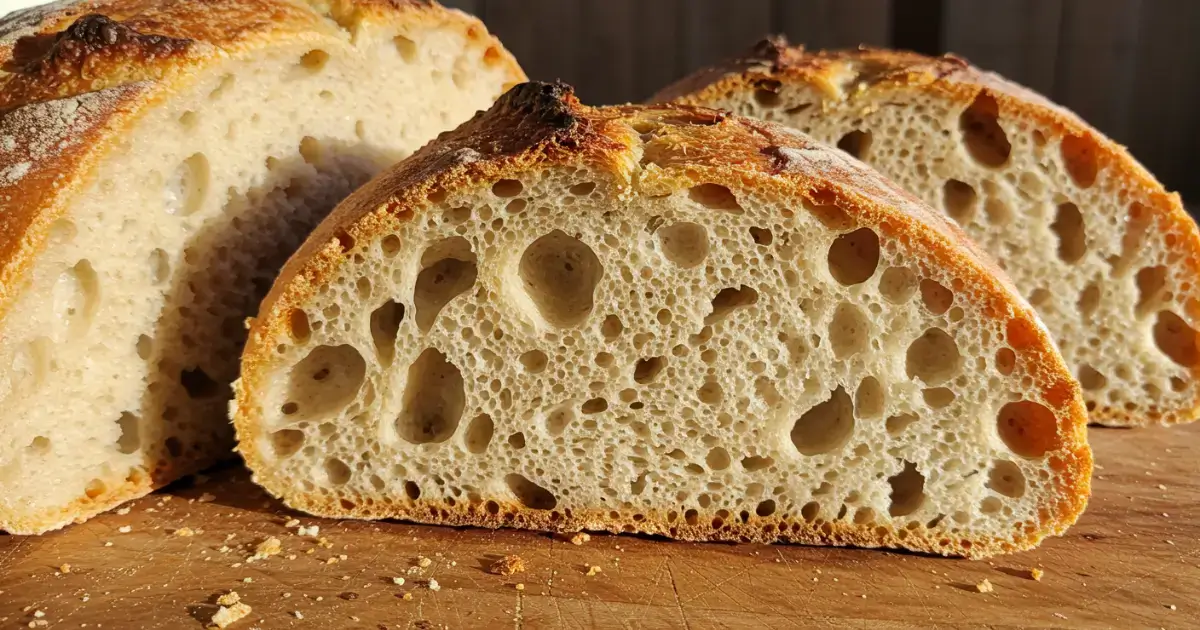Pugliese bread is a delicious and rustic Italian bread known for its soft, airy crumb and crispy crust. Its simple ingredients and easy preparation make it perfect for any meal, whether you’re dipping it in olive oil, serving it with soup, or using it for sandwiches. This bread brings a taste of Italy into your kitchen.
Key Benefits of Pugliese Bread
Pugliese bread is not just another loaf; it’s an experience. Here’s why it should be your go-to bread:
- Hearty and Delicious Texture: The bread’s airy crumb combined with its crisp, golden crust creates the perfect balance of softness and crunch. It’s the kind of bread that’s satisfying on its own or paired with other dishes.
- Simple, Natural Ingredients: Made with just a few basic ingredients—flour, yeast, salt, and water—Pugliese bread is a great way to enjoy authentic, homemade Italian bread without complicated steps. The key is in the high hydration dough, which gives it that signature airy texture.

- Versatility: This bread is a true all-rounder. Whether served as a side to soups and stews, used in sandwiches, or dipped in olive oil, its subtle flavor makes it an ideal companion to almost any meal.
- Perfect for Baking at Home: Pugliese bread offers a wonderful opportunity for you to try your hand at artisan bread-making. It doesn’t require fancy equipment—just a little patience and time. The result is an incredibly satisfying, freshly baked loaf that will impress everyone around the table.
Ingredients for Pugliese Bread
Active dry yeast: Active dry yeast is necessary for leavening. Instant yeast can be used as a substitute, but rise times may vary.
Salt: Salt enhances the bread’s flavor and helps regulate yeast activity for an even rise.
Olive oil: Olive oil adds richness and moisture to the dough and helps create a golden, crispy crust. Vegetable oil can be used as a substitute, though the flavor may change.
Semolina flour: Semolina flour is used on the dough’s surface to give the bread texture. Cornmeal can be used as a substitute if semolina is unavailable.
Instructions for Making Pugliese Bread
Follow these simple steps to create your own fresh, homemade Pugliese bread. The process is straightforward, and with a little patience, you’ll have a beautiful loaf to enjoy.
Activate the Yeast: Mix warm water and yeast in a bowl. Let it sit for 5-10 minutes until foamy.
Mix the Dough: Combine flour, salt, activated yeast, and olive oil in a bowl. Stir until it forms a sticky dough.
Knead the Dough: Turn the dough onto a floured surface and knead for 8-10 minutes until smooth and elastic.
First Rise: Shape the dough into a ball and place it in an oiled bowl. Cover and let it rise for 1-2 hours until doubled in size.
Shape the Dough: Punch the dough down and shape it into a round loaf.
Second Rise: Place the dough on a baking sheet and let it rise for 45 minutes to 1 hour.
Preheat the Oven: Heat your oven to 220°C (425°F).
Bake the Bread: Bake the dough for 25-30 minutes until it is golden brown and sounds hollow when tapped.
Cool and Serve: Let the bread cool on a rack for 20 minutes before slicing. Enjoy!
With these simple steps, you’ll create a rustic and flavorful loaf of Pugliese bread. The key is patience—let the dough rise properly and bake it until it’s golden and delicious.
Pro Tips for Perfecting Pugliese Bread
Making Pugliese bread is an incredibly rewarding experience, but a few tips can take your loaf from good to great. Here’s how to ensure your bread turns out perfectly every time:
Use the Right Flour
For the best texture, opt for high-quality flour. Pugliese flour is ideal, but if you can’t find it, go for an unbleached, all-purpose flour with a decent protein content. This will help the dough rise properly and give you that signature airy crumb.
Hydrate the Dough Well
The dough for Pugliese bread is supposed to be slightly sticky. Don’t be tempted to add too much flour while kneading. The wetter dough gives the bread its soft, airy texture, so embrace the stickiness!
Give It Time to Rise
Don’t rush the rising process. Let the dough rest and rise at its own pace. The more time you allow for the dough to ferment, the better the flavor and texture will be. A slow rise at room temperature will enhance the bread’s depth of flavor.
Preheat Your Oven Thoroughly
Ensure your oven is fully preheated before baking. A hot oven is crucial for achieving the perfect crust. If you have a pizza stone or an inverted baking sheet, use it to help create a crispier bottom crust.
Steam for a Crunchy Crust
If you want to achieve that perfect, golden, crunchy crust, try placing a pan of water in the oven while the bread bakes. The steam helps to create a crispy exterior, which is a hallmark of Pugliese bread.
Let It Cool Completely
Once your Pugliese bread is baked, resist the temptation to slice into it right away. Let it cool for at least 20 minutes before cutting. This allows the crumb to set and gives the flavors a chance to develop fully.
These tips will help you create a delicious, perfectly textured loaf of Pugliese bread every time. With a little practice, you’ll be baking like a pro in no time!
Variations of Pugliese Bread
While the classic Pugliese bread recipe is delicious on its own, you can customize it to suit your taste or try different versions. Here are a few fun variations to consider:
Add Olives for a Mediterranean Twist
Pugliese bread pairs beautifully with olives. You can fold in roughly chopped Kalamata or green olives during the mixing stage to add a salty, briny flavor that complements the soft, airy texture of the bread.
Herb-Infused Pugliese
For a fragrant, savory option, try adding dried or fresh herbs like rosemary, thyme, or oregano. Fold them into the dough just before the first rise. This will infuse your bread with a delightful Mediterranean aroma and flavor.
Cheese Lover’s Pugliese
If you’re a cheese fan, consider adding cubed mozzarella or grated Parmesan to the dough. The cheese melts into the bread, creating little pockets of gooey goodness, and the salty richness enhances the overall flavor.
Garlic and Rosemary Pugliese
For a bold twist, incorporate roasted garlic and fresh rosemary into the dough. The garlic will bring a lovely sweetness to the bread, while the rosemary adds a savory, aromatic note. This is perfect for serving with a rich pasta or as a standalone snack.
Whole Wheat Pugliese
Want to make a healthier version? Substitute part of the white flour with whole wheat flour. This adds more fiber and gives the bread a nutty, hearty flavor. Just keep in mind that whole wheat flour can make the dough a bit denser, so you may need to adjust the hydration slightly.
Serving Suggestions for Pugliese Bread
Pugliese bread is incredibly versatile and pairs perfectly with a variety of dishes. Here are a few simple and delicious serving ideas:
Serve with Soups
Pugliese bread is ideal for soaking up the flavorful broth of hearty soups. Try it alongside rich tomato soup, minestrone, or a savory chicken broth. The bread’s chewy texture complements the soup, making each bite satisfying.
Toast for Breakfast
Toasted Pugliese bread makes a wonderful breakfast. Top it with your favorite spreads like butter, jam, or avocado. You can even add a poached egg for an extra boost of protein. It’s a delicious and easy way to start the day.
Pair with Olive Oil
For a simple yet flavorful treat, serve Pugliese bread with a drizzle of high-quality extra virgin olive oil. The bread absorbs the oil’s richness, offering a light and satisfying snack or appetizer.
These easy serving suggestions make Pugliese bread a delicious addition to any meal. Whether it’s soup, breakfast, or just a snack, it’s sure to impress!
More Bread recipes you will love!
FAQs About Pugliese Bread
Here are some frequently asked questions about Pugliese bread to help you learn more about this delicious, rustic loaf:
Why is Pugliese Bread Famous?
Pugliese bread is famous for its light, airy texture and rich, slightly tangy flavor. Originating from the Puglia region in Southern Italy, this bread is known for its large, irregular holes and chewy crumb. It’s a staple in Italian cuisine, often enjoyed with olive oil, soups, and stews.
Is Pugliese a Sourdough?
While Pugliese bread shares some similarities with sourdough, particularly its slightly tangy taste, it is not technically sourdough bread. It’s made with a biga (a type of Italian starter), which contributes to the bread’s unique flavor and texture. Unlike traditional sourdough, Pugliese does not rely on wild yeast.
What Does Pugliese Bread Taste Like?
Pugliese bread has a mild, slightly tangy flavor with a chewy, airy crumb. The crust is golden brown and crisp, offering a satisfying contrast to the soft interior. It’s a wonderfully versatile bread, great on its own or paired with various dishes.

pugliese bread
Ingredients
- 500 g Pugliese flour or all-purpose flour
- 325 ml water
- 10 g salt
- 7 g active dry yeast
- 2 tablespoons olive oil
Instructions
Activate the Yeast
- In a small bowl, combine the water and active dry yeast. Let it sit for 5-10 minutes or until it becomes foamy. This ensures the yeast is active and ready to work its magic in your dough.
Mix the Dough
- In a large mixing bowl, combine the flour and salt. Pour in the activated yeast mixture and olive oil. Stir with a wooden spoon until the dough starts to come together. The dough will be a bit sticky, which is normal for Pugliese bread. Don’t worry, it will all come together nicely.
Knead the Dough
- Lightly flour your work surface and turn the dough out onto it. Knead the dough for about 8-10 minutes or until it becomes smooth and elastic. If the dough feels too sticky, add a little more flour, but try not to overdo it—this dough benefits from a slightly wet texture for that airy crumb.
First Rise
- Shape the dough into a ball and place it in a lightly oiled bowl, covering it with a damp towel or plastic wrap. Let it rise for about 1-2 hours or until it has doubled in size. Find a warm, draft-free spot for the dough to rise—this will help it rise more effectively.
Shape the Dough
- Once the dough has risen, gently punch it down to release the air. Turn it out onto a lightly floured surface and shape it into a round loaf. You don’t need to worry about making it perfect—rustic is the beauty of Pugliese bread.
Second Rise
- Place the shaped dough onto a baking sheet lined with parchment paper. Cover it again and let it rise for another 45 minutes to 1 hour, allowing the dough to puff up nicely.
Preheat the Oven
- While the dough is rising, preheat your oven to 220°C (425°F). Place a baking stone or an inverted baking sheet in the oven to heat up, which will give the bread a great, crispy crust.
Bake the Bread
- Once the dough has risen, place it into the preheated oven. Bake for 25-30 minutes or until the loaf is golden brown and sounds hollow when tapped on the bottom. If you have a thermometer, the internal temperature of the bread should be around 90°C (190°F).
Cool and Serve
- Let the bread cool on a wire rack for at least 20 minutes before slicing. This allows the crumb to set and the flavors to develop. Enjoy your freshly baked Pugliese bread with olive oil, your favorite spread, or alongside a hearty meal.
Send me this recipe!
Just enter your email below and get it sent straight to your inbox!


